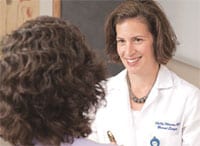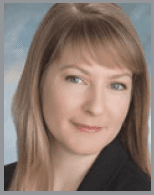Radioactive Seed Localization Baystate Offers New Option for Women Undergoing Lumpectomies
With every medical advance, it seems, comes a new challenge.
“As the technology behind screening mammograms has become more refined,” said Dr. Grace Makari-Judson, medical director of Baystate Health’s Comprehensive Breast Center, “we are able to detect a greater number of breast abnormalities and cancers before they can be felt with a physical exam. While this allows us to catch problems earlier than ever, it also makes the affected tissue more challenging to precisely locate and remove.”
For women with breast cancer who will undergo a lumpectomy, the wire-localization procedure (WLP) has long been the standard. With this protocol, the radiologist places a guide wire into the area of concern in the breast using mammography prior to the surgery. During the surgery, the surgeon removes the tissue surrounding the guide wire and sends it to the laboratory for biopsy.
“While WLP is very useful, it also presents several challenges,” said Dr. Holly Mason, director of Breast Surgical Services at Baystate. Since the guide wire cannot be placed into the breast until the day of surgery, scheduling the surgery is more complicated. The placement of the wire is very uncomfortable for the patient. The wire may shift or be dislodged, decreasing the accuracy of the procedure. The wire is very thin and can be difficult to feel within the breast tissue, and the location where the wire exits the skin does not always reflect the location of the tumor, making incision planning difficult.
“Finally,” she continued, “the wire and the mammograms showing the wire placement provide only a limited view of the location of the tumor, which can make removal of the tissue less accurate, potentially requiring a re-excision.”
Radioactive seed localization (RSL) offers a new alternative. With this procedure, a radiologist places a very low-energy radioactive seed into the abnormal tissue or tumor, guided by mammography. During the surgery, the surgeon uses a handheld Geiger counter to more precisely identify the location of the tumor. The Geiger counter also allows the surgeon to obtain a three-dimensional view of the tumor’s location.
RSL offers multiple benefits over WLP, Mason said. The radiologist can implant the seed up to a week before the surgery, thereby making the scheduling process easier and reducing the wait time for patients. The seed placement is also better tolerated by patients than the wire.
More importantly, said Mason, who is currently the only surgeon in the region trained to perform RSL, the procedure provides increased accuracy over WLP. With RSL, the surgeon knows the precise location of the tumor and can more accurately plan the surgical incision. This also reduces the length of the surgery. In addition, studies show that RSL reduces the need to have a second surgery due to incomplete removal of the abnormal tissue.
Seed Implantation
Patients have an appointment at Baystate’s Chestnut Surgery Center up to a week prior to their surgery for the implantation of the seed. A specially trained radiologist performs the seed implantation, assisted by a mammography technologist.
The seed placement procedure is very similar to a needle biopsy procedure. The radiologist injects a local anesthetic to numb the area before starting the procedure. Mammography is used to guide placement of the seed. The seed (iodine 125, or I-125) is of very low energy, and its placement is not considered to be dangerous to the patient.
On the day of the lumpectomy, the patient arrives about two hours before the surgery and receives an IV with light sedation and a local anesthetic to numb the surgical area. After the surgeon removes the abnormal tissue or tumor along with the radioactive seed, the incision is closed and bandaged. Once the seed is removed with the breast tissue, all of the radioactivity is gone. The patient is able to leave the hospital later that same day.
Most patients are potential candidates for RSL, with the exception of women who are pregnant, who have implants, or with lesions close to the chest wall or skin. While there is likely little risk to the fetus because of the low energy radiation of the seed, it is best to avoid any radiation exposure, so pregnant women are scheduled for the wire-localization procedure. Women who are breastfeeding are asked not to nurse while the seed is in place.
“We are very pleased with the results we have seen so far,” Mason said. “The seed allows me to be much more accurate during the surgery while reducing the amount of time it takes, and the process is smoother for the patient as well.”


